If you’re a science geek with a passion for writing, learning how to start a science blog could be the perfect way to share your knowledge with the world and make some money in the process.
In this post, we’ll walk you through how to start a new science blog and make money online. You will learn how to choose your science blog’s niche, create a science blog in WordPress and write blog posts. Then I will show you how to promote your science blog to get traffic along with how to monetize your science blog to make money.
So what are you waiting for? Let’s jump in!

How to Start a Science Blog in 7 Steps
- Define Your Science Blogging Goals
- Choose a Science Niche
- Pick & Register a Blog Domain Name
- Setup WordPress
- Write & Publish Blog Posts
- Promote Your Science Blog
- Monetize & Make Money
1. Define Your Science Blogging Goals
The first step in starting a science blog is to figure out your goals. That might sound like an obvious thing to do, but it’s important to have a clear focus for your blog from the start.
Are you blogging for fun? Do you want to build a following and be seen as an expert in your field? Do you want to make money from your blog?
Your goals will determine how you approach blogging, what kind of content you write, and how you promote your blog. So it’s worth taking some time to think about what you want to achieve with your science blog before you get started.
What is a Science Blog?
A science blog is a blog that covers topics related to science which can include physics, environment, biology, psychology, health & medicine, neuroscience, space, and astronomy.
Why Start a Science Blog?
There are several reasons you might want to start a science blog.
For one, it’s a great way to share your knowledge and passion for science with the world. If you’re an expert in your field, a science blog is a great platform to share your insights and show off your expertise.
Starting a science blog can also be a great way to build up your professional network and make connections with other scientists and writers.
And if you’re looking to make money from your blog, there are a few ways you can monetize a science blog which we’ll cover later in this post.
The benefits of starting a science blog include:
- Become an influencer in science.
- Build a community around your passion for science.
- Network with scientists and thought leaders in the industry.
- Make money online blogging.
How much money can you make from science blogging?
You can make $15-$25 for every 1000 ad views on your science blog. An SEO optimized blog post can get anywhere between 300 to 1000 visits per month. So, a science blog with 100 blog posts can make as high as $2500 every month. You can make even more money if you monetize with affiliate marketing and digital products.
2. Choose a Science Niche
The next step in starting a science blog is to choose a niche.
A niche is a specific topic or area that you’ll be writing about on your blog. For example, some science blogs focus on environmental issues, others might focus on health and medicine, and still, others might focus solely on space exploration.
Why choose a niche?
When you’re starting a blog, it’s important to choose a niche so that you can focus your content and build up an audience of people who are interested in what you have to say.
If you try to write about everything, you’ll end up with a scattered blog that confuses readers and doesn’t attract much of an audience.
But if you focus on a specific topic, you can build up a loyal following of readers who are interested in what you have to say.
When you choose a niche, it’s also easier to come up with blog post ideas and market your blog to the right people.
Finding Your Ideal Niche
The best way to find a profitable niche for your blog is to start with something you’re interested in.
Think about the topics you’re passionate about and what kinds of issues you like to read about when it comes to science. Once you have a general idea of the direction you want to go in, you can start narrowing down your focus.
To help you get started, here are a few of the popular science niches:
- Physics
- Quantum Physics
- Cosmology & Astronomy
- Space Exploration
- Technology
- Animals & Wildlife
- Plants
- Paleontology
- Evolutionary Biology
- Chemistry
- Neuroscience
- Psychology
- Health & Medicine
Come up with a few niche ideas.
Examples of Science Blog
Sometimes looking at other science blogs will help inspire ideas of your own. Here are some of the more popular examples of science blogs:
1. IFL Science
The blog writes engaging, amusing, and thought-provoking science content that goes viral on social media. They cover a broad range of topics from environment, technology, space, and medicine.

2. Science Sparks
This blog focuses on fun and creative science experiments and projects for kids. The blog is filled with science activities that helps kid learn science and have fun in the process.

3. Space & Beyond Box
This is a blog that is focused on space and covers the latest news and interesting facts on space. They have monetized their blog by selling a space-themed subscription box.

4. Mind Hacks
This is a blog by Tom Stafford & Vaughanbell where they share neuroscience and psychology tricks to help you understand what is going on in your brain. They share their content on Twitter with their followers.

5. Towards Data Science
This blog is focused on helping people become better data scientists. They have a very large following.

3. Pick & Register a Blog Domain Name
Once you have chosen your niche, it is time to brainstorm a few names for your science blog.
We recommend you keep your science blog’s name to two words (Example: Mind Hacks). One of the two words should be a keyword from your niche. The other word can be something that makes your website brandable. For example, our blog teaches people how to make passive income, so we have named it Passive Book.
Here are some of the words that you can mix and match into your blog name:
- Science
- Sci
- Scientist
- Scientific
- Space
- Cosmos
- Physics
- Phys
- Animals
- Mind
- Psychology
- Psych
- Neuro
- Climate
Use a Business Name Generator to brainstorm the name of your blog.
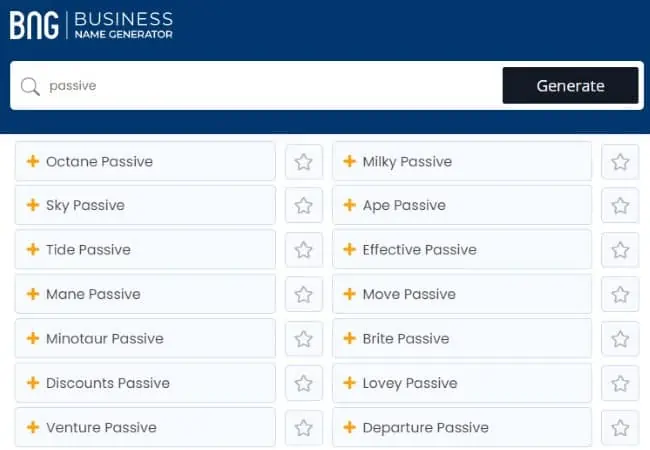
You can also use your own name for your blog. But if you ever plan to sell your website in the future, it is much more difficult to transfer your brand to the buyer when it is your name.
Check Domain Name Availability
After you have brainstormed a few names for your science blog, you should check if the .com domain name is available.
A domain name is the web address that people type into their browsers to visit your science blog. It is usually your science blog’s name followed by .com. For example, the domain name of this website is passivebook.com.
You must check if both the .com domain name and the social media handles are available. You can use Namechk to check the availability of both your domain name and social media handles.
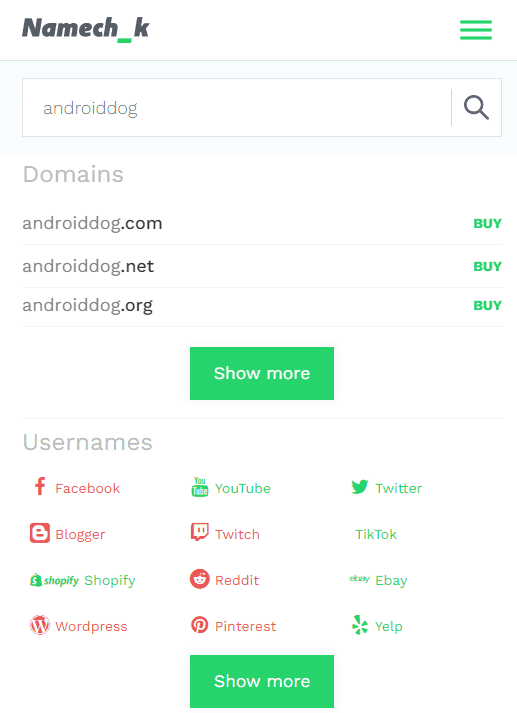
Here are a few things to keep in mind when selecting a domain name:
- Choose a .com domain name. 86% of the internet uses .com, so your visitors are likely to try visiting your blog by typing .com. Avoid other extensions like .net or .org.
- Don’t include hyphens and numbers.
- Do not use words with multiple spellings (for example colour vs color).
- Shorter domain names are better. Try to keep it under 12 characters.
- Spelling & Pronunciation should be easy and intuitive.
- It should be easy to remember.
- Avoid words that can be misread together. For example, therapistjohn.com can be read as Therapist John or The Rapist John.
- Make sure it’s not trademarked or copyrighted by someone else. The AI writing software Jarvis.ai had to rebrand to Jasper.ai because Marvel sued them for the Iron Man reference. Lawsuits will happen once your blog is established.

Register a Domain Name
Once you decide your domain name it is time to register it.
You should register your domain with NameCheap because you will get domain privacy for free. Other providers charge $12 per year for domain privacy. Without domain privacy, your name, home & email address will be accessible to the public.
Step 1: Go to NameCheap. Enter your domain name with the .com extension.
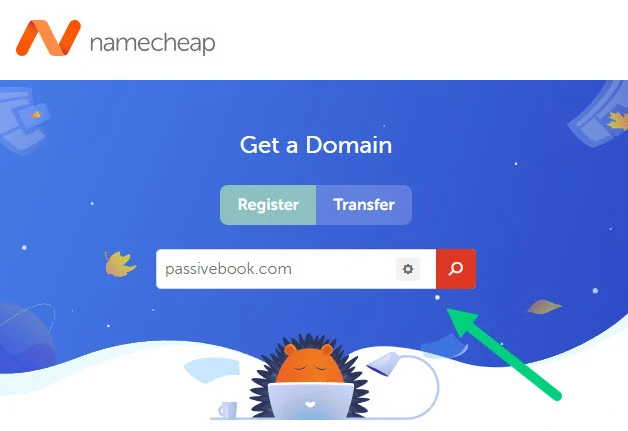
Step 2: Select the .com extension and click the Add to Cart button.
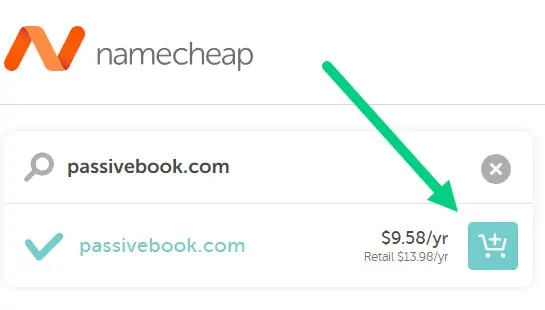
Step 3: After adding the domain to the cart, click on the Checkout button.

Step 4: Enable Domain Privacy that comes for free along with auto-renew. You don’t need any other paid addon.

Step 5: Click on Confirm Order. Pay to complete your purchase.
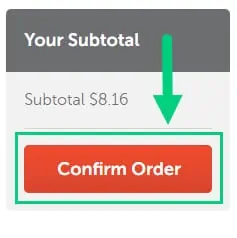
Step 6: Log in to Namecheap and click on Domain List ❶ in the left sidebar and then click Manage ❷ next to the domain you just purchased.
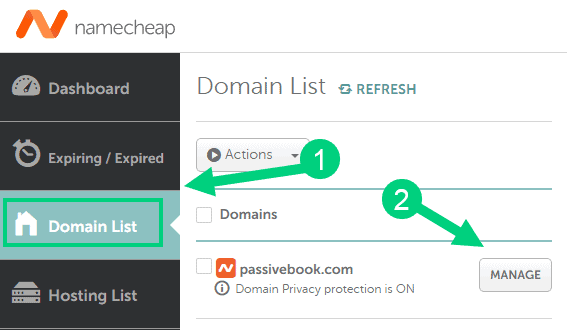
Step 7: Under the Nameservers section, select “Custom DNS” from the dropdown ❶. Then enter the following two nameservers ❷ ns1.bluehost.com and ns2.bluehost.com as shown in the image. Then click the green tick ❸ to save. If you use a hosting provider other than Bluehost, enter their nameserver values in this step instead.
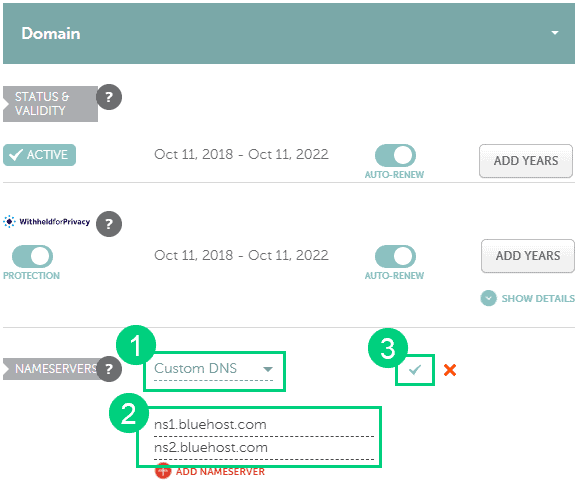
Can I get a free domain name?
Your web hosting provider might give you a free domain name for one year but they charge $12 for domain privacy which is free in Namecheap. From the second year, you will pay for both the domain and privacy which will cost you more than $20+. So it is cheaper to just register your domain with Namecheap from the beginning. Also using different companies for web hosting and domain registration will allow you to easily switch your blog host later without transferring domains.
Can I change the name of my blog later?
You will lose your search engine rankings if you change your blog’s name once it gets links from other websites. It will take as long as a year or more for you to regain the lost traffic. It is possible to mitigate problems by having proper redirects. But you will have to renew both your old and new domains every year. So try to avoid changing your blog’s name once it is established.
4. Setup WordPress
The next step is to get your blog up and running in WordPress.
WordPress is a content management system (CMS) that makes it easy to create a science blog from scratch without learning how to code.
Why Choose WordPress.org?
There are many blogging platforms but the self-hosted wordpress.org powers 70% of blogs on the internet. 42% of all websites on the internet use WordPress.

Here are some of the benefits of using WordPress:
- WordPress is a free and open-source software.
- You get complete ownership and control of your website as you can host it anywhere.
- It is very easy to use with a friendly user interface. You can create posts and pages, add images, videos, etc without learning how to code.
- It is customizable with thousands of themes and plugins. You can make your site look however you want and you can add whatever functionality that you want.
- It is Search Engine Optimization (SEO) friendly which means your website will rank higher in Google search results.
- It is fast and secure. WordPress websites are usually faster than other websites because of how well it is coded. Also, there are many security plugins that you can install to keep your website safe from hackers.
- There is a large supportive community of WordPress developers and users. You can find answers to any questions that you have pretty easily.
WordPress.org vs WordPress.com
There are two versions of WordPress.
- WordPress.com is a hosted solution that is easy to use but has many limitations, for example, you cannot install plugins or themes and you cannot run ads or make money from your blog. We do not recommend it for science bloggers who want to turn their blog into a business.
- WordPress.org is the self-hosted version of WordPress. You will need to buy a domain name and hosting from a provider like BlueHost, but it gives you complete control over your blog. You can run ads, install plugins, and make money from your blog.
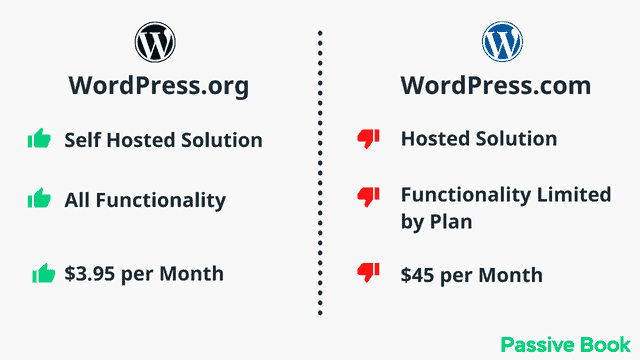
We recommend using WordPress.org for your science blog because it is the most flexible platform that gives you complete control over how you want to design and monetize your website.
Why Avoid Free Blogging Platforms
There are many free blogging platforms like Blogger, Tumblr, and Medium. But we do not recommend using them for the following reasons:
1. They can delete your blog without any warning if they do not like what you are writing about.
2. You do not own your content. For example, if you write a popular post on Medium, they can put it behind a paywall and only people who pay can read it.
3. They can change the rules at any time. For example, Tumblr used to allow adult content but they recently banned it. Your blog can get deleted for no reason if the algorithm thinks you are spamming. This is what happened to many blogger blogs. Blogger blogs are also notorious for deleting blogs without warning.

4. It is hard to monetize your blog. For example, you cannot run ads on Blogger and you can only run a limited number of affiliate links on Tumblr.
How much does it cost to start a science blog?

It will cost you $2.95 per month to host your WordPress science blog in Bluehost. A domain will cost you $12/year. So that is a total of $4.2 per month, which is less than the price of Netflix for all the unlimited features that a self-hosted WordPress blog has to offer.
What to do if you already have a free blog?
Migrating to a self-hosted WordPress blog from a free blogging platform like Blogger or Tumblr is very easy. All you need is a WordPress import plugin. The plugin will automatically migrate all your data (posts, comments, images, etc) from your old blog to WordPress.
Install WordPress in Hosting
Before you can install WordPress and set up your science blog, you need to get your hosting set up.
Hosting is a service that provides the server space to store the blog posts, files, and images of your science blog.
When someone visits your science blog in a browser like Chrome or Firefox, your web host will load files from their server into your visitor’s browser, allowing them to access your science blog.
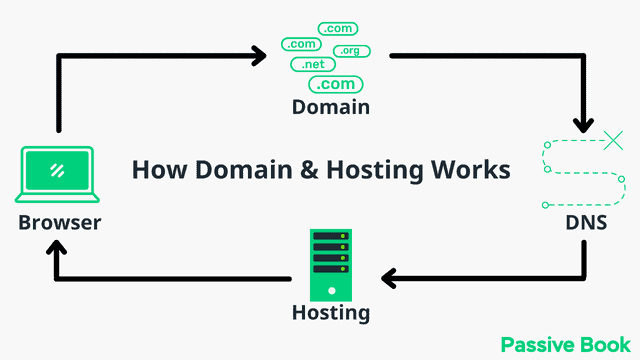
For this guide, we will use BlueHost as our web host. It is a cheap hosting that is extremely easy for beginners to set up. If you use any other web host, the steps will be the same but the user interface may be slightly different.
1. Go to BlueHost using this link to get a special discount. Select WordPress > WordPress Hosting from the top menu.
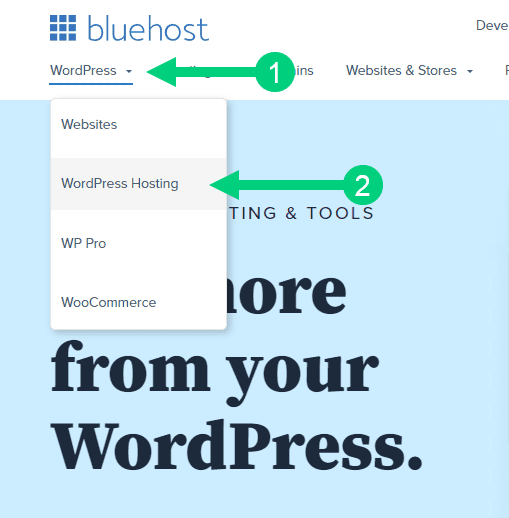
2. Click on the button you see on this page and you will be taken to the pricing section.

3. Select the Basic Plan. You can upgrade to a different hosting plan as you grow.
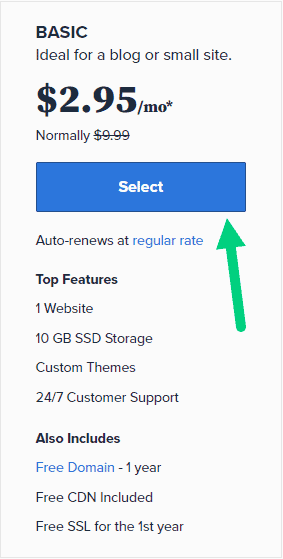
4. If you already have a domain name that you purchased with Namecheap you can put that in the “Use a domain you own” ❶ section. If you don’t have a domain name yet, choose the “Create a New Domain” ❷ to purchase a new domain.
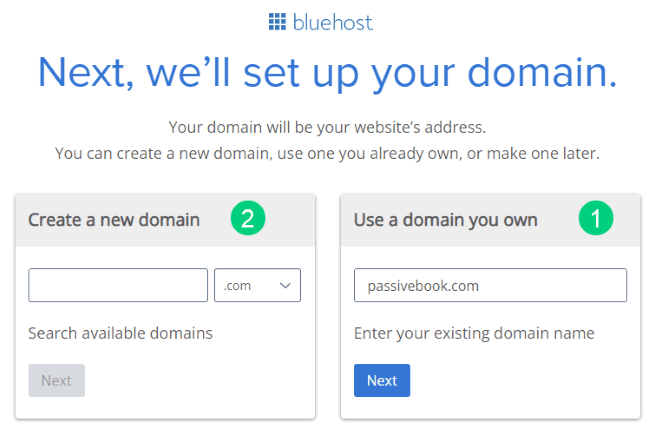
5. In the next screen, enter your information. Uncheck all package extras. If you purchase your domain through Bluehost instead of Namecheap, you may want to enable Domain Privacy. You won’t see the Domain Privacy option if you bought your domain through Namecheap. Namecheap will give you this Domain Privacy for free.
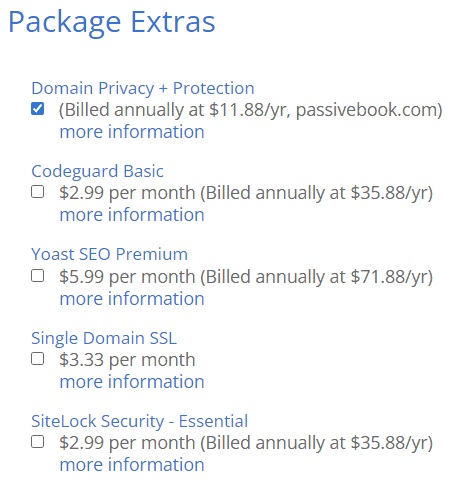
6. Once you have successfully paid, you will be prompted to set a password. Click on the “Create your Password” button.
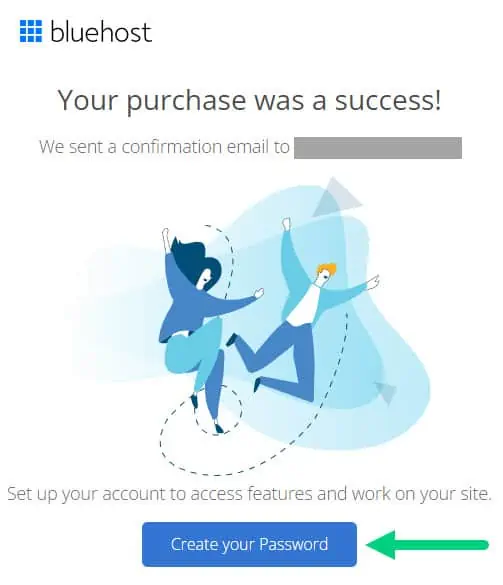
7. Enter your password and create your account. If you lose this password, you can reset it.

8. After you set your password, log in to Bluehost.
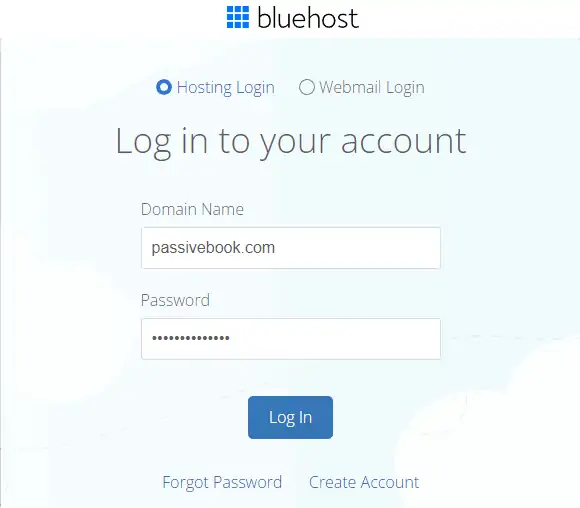
9. Click on the Create your website button on the following screen. This will start a Bluehost Wizard, just click Skip this step wherever possible.

10. On the following page, click “No help needed” or “Skip this step”. We don’t want Bluehost to limit our customization options.
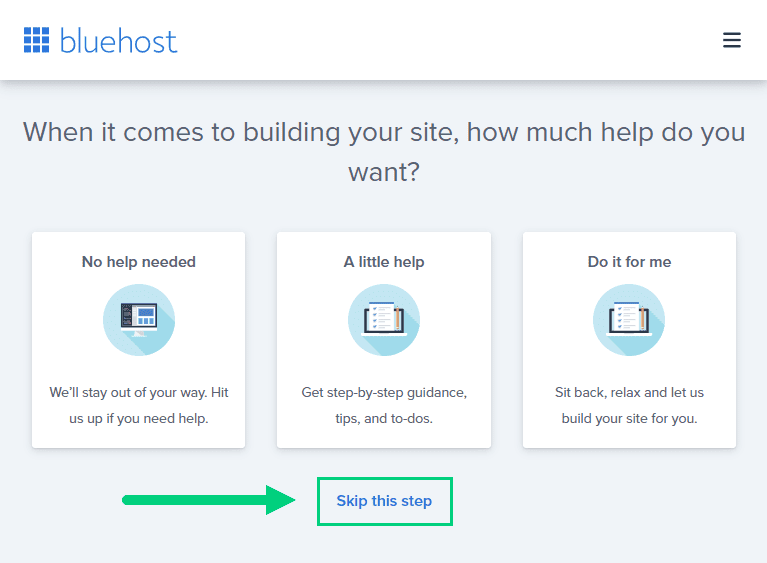
11. On the next page, you will be asked about the purpose of your website. You can choose from any of the available options.
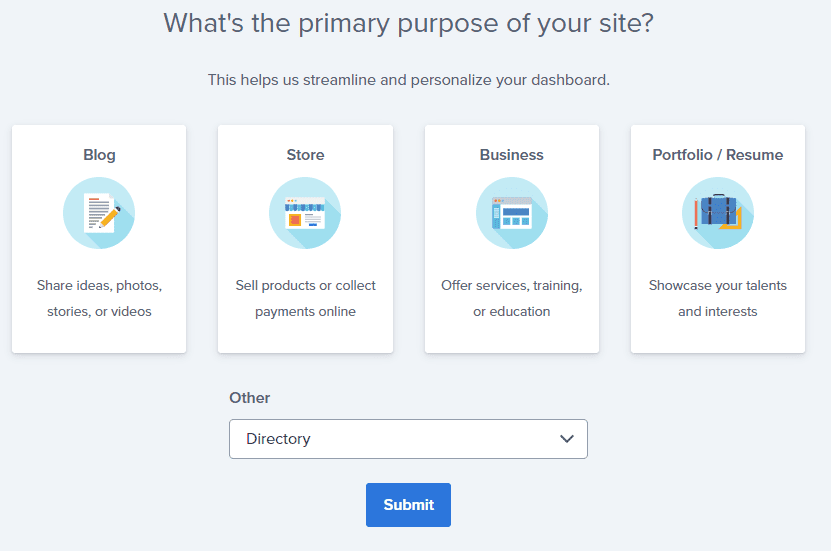
12. On the next page, click Skip this step.

13. On the following page, enter the blog’s name and tagline. You can change this later so feel free to click “Skip this step” or enter something as a placeholder and click Continue.
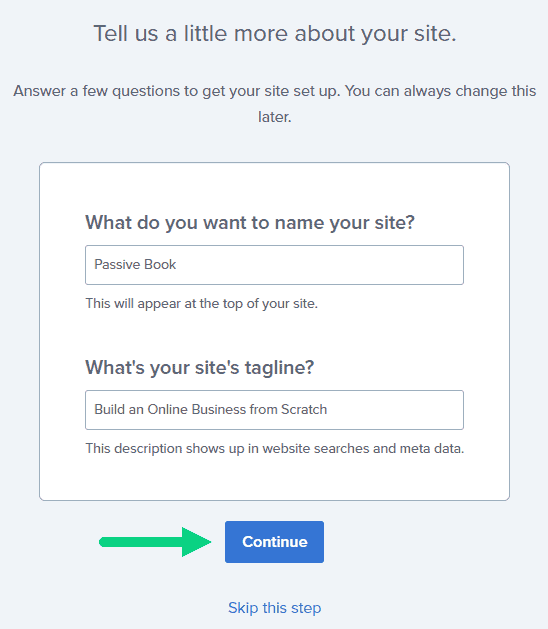
14. Finally you will be asked how you want to build your website. Choose “Limitless customization” to have all the options.
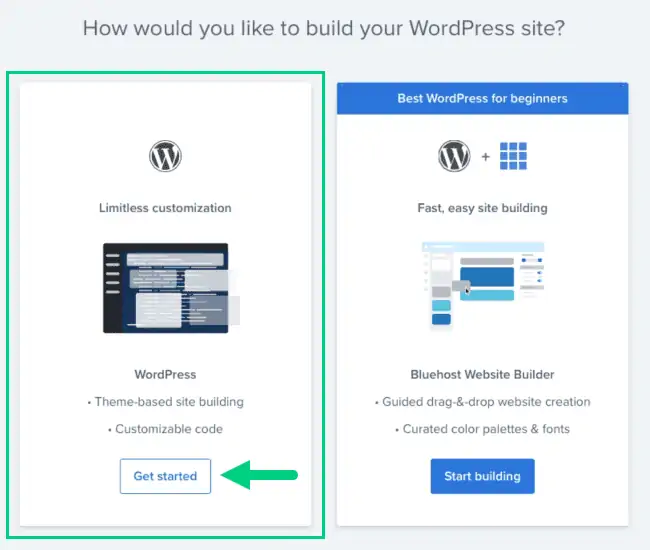
15. You can see your blog by going to yourdomain.com. Go to the Bluehost dashboard and click on the My Sites tab ❶ in the left sidebar and click on the “Manage site” button ❷.

16. Your WordPress site has separate login credentials different from the ones you use to log into Bluehost. You can use this to log in to the WordPress dashboard directly without logging into Bluehost. To get this:
❶ Click on Users on top.
❷ You will be able to see your username and email that you can use to log in to WordPress.
❸ If you click on the three dots you will see the option to Reset your password. ❹
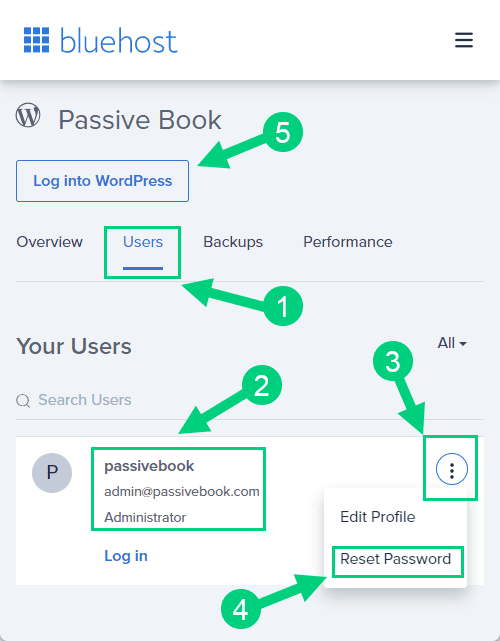
You can log into WordPress from the Bluehost dashboard by clicking the Log in to WordPress button ❺. But it is not recommended you rely on this as your primary login method because you will get locked out of your site if you ever change hosting providers.
17. You will be taken to the WordPress dashboard where you can reset your password ❶. If you don’t like the username Bluehost created for you, you can Add a New User ❷.

18. If you are adding a new user make sure you specify the user role as Administrator ❶. You can log in as the new user and safely delete the default user created by Bluehost.
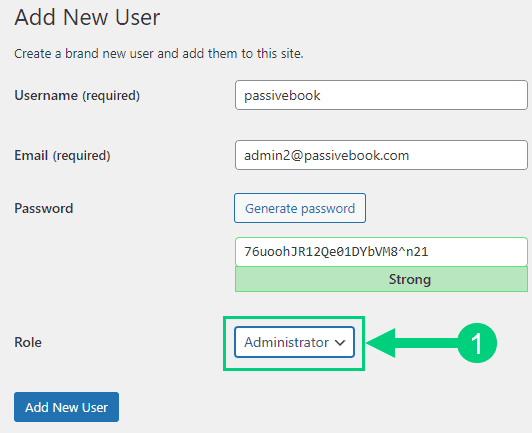
Congratulations! You have successfully set up WordPress.
Configure WordPress
Now that you have the basic version of WordPress installed, it is time to customize it to make it look and feel the way you want.
Login to WordPress Dashboard
The WordPress Dashboard is the central location where you can control all the aspects of your science blog. You can add new posts, check your stats, change your settings, and more from the dashboard.
Visit yourdomain.com/wp-admin to access the WordPress dashboard.

Use the Email and Password you provided during installation to log in to your WordPress dashboard. If you don’t have a password, use the “Lost your password?” to generate a new password.
Install WP Themes
A WordPress Theme is a collection of files that control the look and feel of your science blog.
Your new WordPress blog will be installed with a default blog theme that doesn’t look very great.
To install a new WordPress Theme:
Go to Appearance > Themes > Add New in your WordPress dashboard.
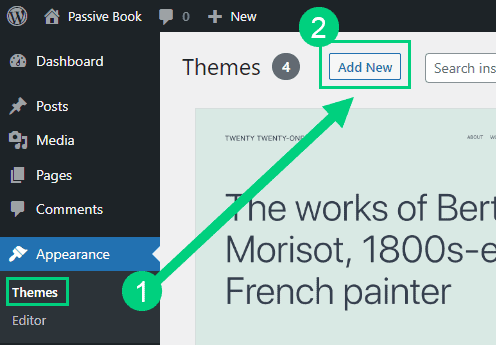
Use the search to find a theme that you like ❶. Before you install the theme, you can see a demo of the theme and learn about its features from the preview screen ❷. If you like the theme, you can install it by clicking the install button ❸. You can also upload a theme from a file on your computer ❹.
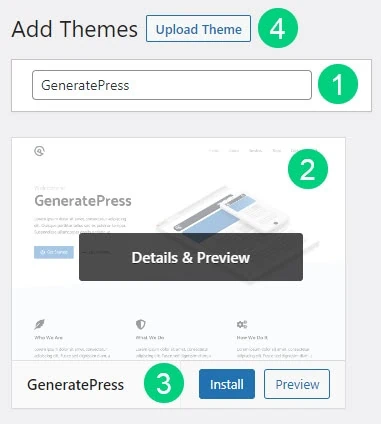
Once installed, click the Activate button to enable the theme.
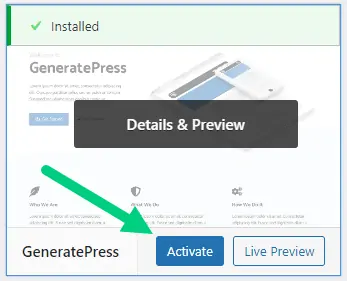
Although you can use a free theme (there are thousands of free themes available), we recommend using a premium theme.
Premium themes not only reduce your website’s load time but also help you customize your website to your heart’s desire.
Here are the premium themes we recommend:
There are also several custom-made science blog themes. These themes tend to be bloated with poor code which will slow down the performance of your website. We suggest getting one of our recommended themes for a fast website with unlimited customization possibilities.
Install WP Plugins
A WordPress Plugin is software that extends the functionality of WordPress. There are thousands of WordPress plugins available for free on the WordPress plugin repository.
Too many wordpress plugins can slow down your blog site. So before you install new plugins, it will be worth clearing out any existing plugins that your hosting provider installed by default.
Plugins first need to be deactivated before they can be deleted.
❶ Go to WP Admin > Plugins > Installed Plugins
❷ Click on the checkbox to select all plugins.
❸ Select Deactivate from the drop-down.
❹ Click Apply.
❺ Repeat the above steps but select “Delete” instead of “Deactivate” from the dropdown in ❸ to delete all the deactivated plugins.
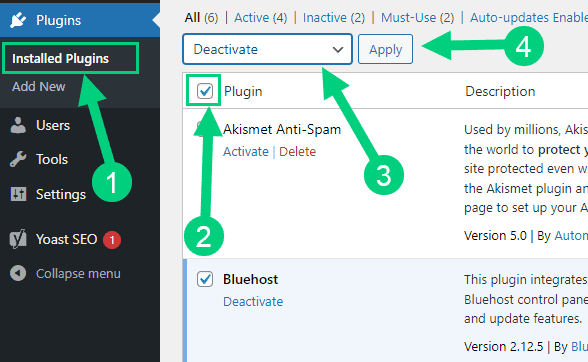
To install new plugins go to the WP Admin > Plugins > Add New.

On the plugins page:
❶ Search for the plugin you want in the search bar
❷ Click Install Now. Once you install the plugin, you must also activate the plugin for it to be enabled.
❸ If you are installing a paid plugin you can upload the plugin instead.

There are many different science blog plugins that you can install, but here are the ones which we recommend:
Backup Plugin: A WordPress Backup Plugin automatically backups your WordPress blog. This is very important because if something goes wrong with your site, you can easily restore it to its previous state.
Recommended Plugin: WPVivid (paid) or UpdraftPlus (free).
SEO Plugin: WordPress SEO plugins help improve the visibility of your science blog in search engines like Google and Yahoo.
Recommended Plugin: RankMath Pro (paid).
Google Analytics Plugin: A WordPress Google Analytics Plugin integrates your website with the Google Analytics tracking service. This allows you to track how many people are visiting your website, where they are coming from, and what pages they are visiting.
Recommended Plugin: RankMath Pro (paid) or GA Google Analytics (free).
Cache Plugin: A WordPress Cache Plugin caches your website’s pages and posts to improve the performance of your website.
Recommended Plugin: WP Rocket (paid).
Page Builder Plugin: A WordPress Page Builder Plugin allows you to create custom pages and posts with drag-and-drop. This makes it very easy to create custom pages and posts without having to learn how to code.
Recommended Plugin: Thrive Architect (paid).
Security Plugin: A WordPress Security Plugin helps you protect your WordPress blog from hackers and malware.
Recommended Plugin: Wordfence (free).
Social Media Plugin: A WordPress Social Share Plugin allows you to easily share your blog posts on social media networks like Facebook, Twitter, and LinkedIn.
Recommended Plugin: Easy Social Share Buttons (paid).
Email List & Lead Generation Plugin: A WordPress Email Opt-in Form Plugin allows you to easily add an email opt-in form to your WordPress blog. This allows you to collect the email addresses of people who are interested in your science blog.
Recommended Plugin: Thrive Leads (paid).
Customize WordPress
Once you have installed your theme and plugins, it is time to customize the wordpress blog platform:
Change Colors, Fonts & Spacing
You can set the font, colors, and spacing by going to Appearance > Customize in your WordPress dashboard. Premium themes like GeneratePress allow you to customize every aspect of your blog.
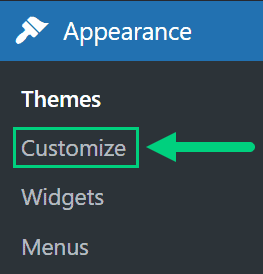
Check out our Blog Fonts & Typography guide to choose the right font and typography settings for your blog.
Add Your Logo
Get a logo designed for your blog from Fiverr. Then set the logo of your blog by going to Appearance > Customize in your WordPress dashboard. A logo is not required for a successful blog but it can definitely help appeal to your target audience.

Change Favicon
Favicon is the image that appears in the browser tab and bookmarks. Set the Favicon from the Appearance > Customize section of the WordPress dashboard.

Create Menus
The header and the footer menu can be set from the Appearance > Menus in your WordPress blog dashboard.

You can nest menu items so that it appears as a dropdown menu ❶. You can use the menu as your primary or secondary navigation menu ❷. Don’t forget to save your menu ❸.
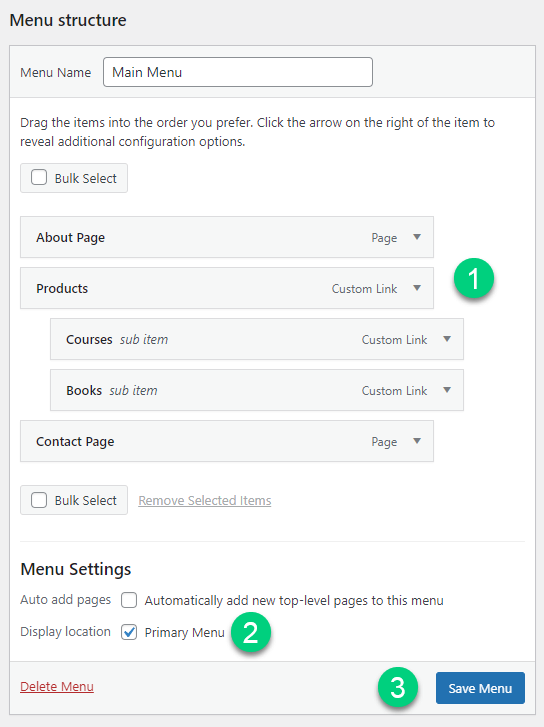
Create Widgets
If you have a sidebar, you can add widgets to it. Go to Appearance > Widgets in your WordPress admin dashboard.
Check out the list of the most useful Blog Widgets and how to add them to your blog.
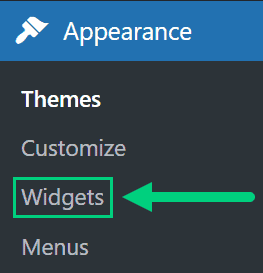
Set Title & Tag Line
The next step is to change your General Settings. Go to Settings > General in the WordPress Admin area.
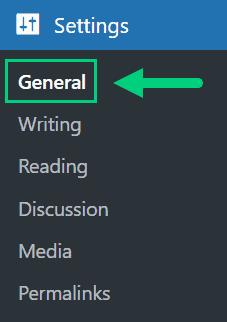
You can set your Site Title, Tagline, and Time Zone from this screen.
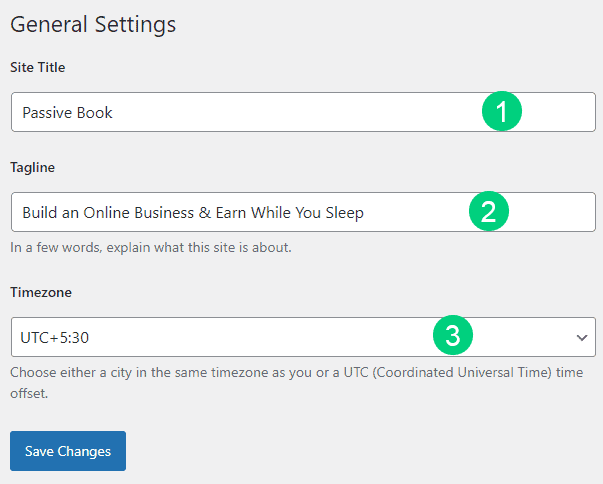
Set Permalinks
The ideal URL structure for SEO is yourdomain.com/sample-post. Set your permalink structure by going to Settings > Permalinks in your WordPress blog dashboard.
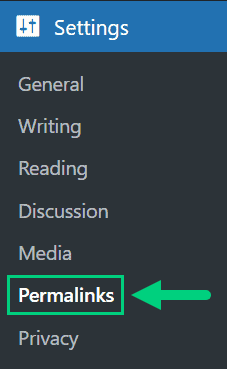
Select the “Post name” radio button and save changes.
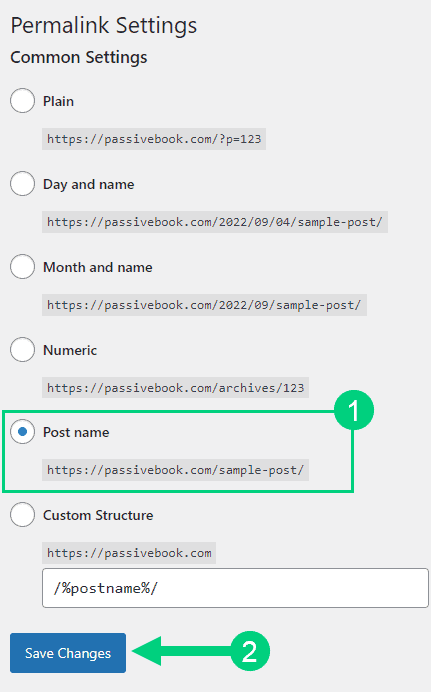
Enable Search Visibility
Chances are you want your blog to show up on Google so people can find you. Go to Settings > Reading in your WordPress dashboard.

To get search engine traffic, ensure the checkbox “Disable search engines from indexing this site” is Unchecked. You can find this option in Settings > Reading. Most of the time this should be unchecked by default but if it is not, then uncheck it to ensure your site gets traffic from search engines.
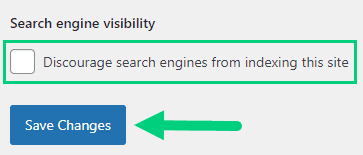
Adjust Comment Settings
Next, you will want to change the Discussion Setting (aka Comments). Go to Settings > Discussion in your WordPress admin area.
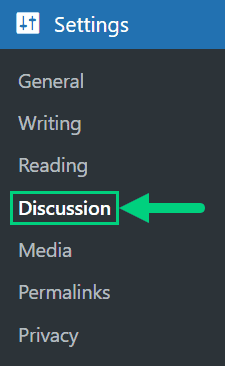
❶ You may want to enable or disable comments on this page. You can also disable pingbacks and enable comment moderation.
❷ You can also set comment approval settings.

If you want to design your blog further, check out our dedicated guide on blog design which has all our best blog design recommendations.
Create Static Pages
There are a few essential pages that you need to create for your science blog before you can start blogging.
Use pages in WordPress to add static content. Go to WP Dashboard > Pages > Add New.
- Write the headline of your content.
- Populate the body content
- Click the publish button.
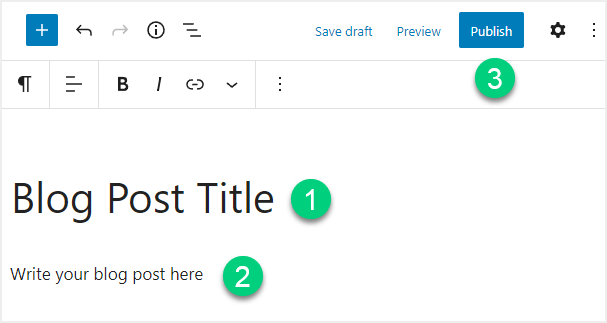
You may want to create the following pages:
Home Page
A home page is the first page that your visitors see when they visit your website. It usually contains a brief introduction to your science blog, as well as some of your latest blog posts.
Some things that you may want to include on your home page are:
- A brief introduction to your science blog
- Your latest blog posts
- A list of your most popular blog posts
- Your contact information

You can create a professional home page for your science blog using a page builder like Thrive Architect.
About Page
An about page is a page where you tell your visitors who you are and what your science blog is all about. This is a great way to connect with your visitors and let them know more about you and your blog.
Some things that you may want to include on your About page are:
- A brief introduction to who you are
- What your science blog is about
- Your qualifications
- Why you started your science blog
- How long you have been blogging

Contact Page
A contact page is a page where you provide your visitors with your contact information. This is a great way to let your visitors know how they can get in touch with you.
Some things that you may want to include on your contact page are:
- Your email address
- Your social media profiles
- A contact form
Use contact form plugins like Fluent Forms to create the form on your contact page.
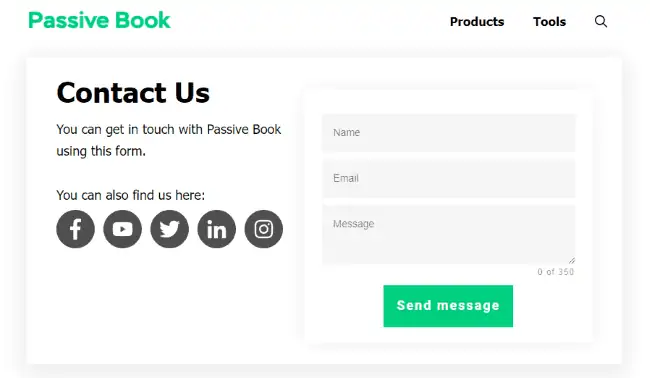
Privacy Policy
A privacy policy page is a page where you tell your visitors how you collect, use, and store their personal information. This is a great way to let your visitors know how their personal information will be used and protected.
Some things that you may want to include in your privacy policy are:
- What personal information do you collect
- How you collect personal information
- Why do you collect personal information
- How you use personal information
- How you store personal information
- Who do you share personal information with
WordPress generates its own privacy policy for you. But you can also use a tool like Termly to generate your own privacy policy.

Terms of Service
A terms of service page is a page where you tell your visitors what they can and cannot do on your website. This is a great way to let your visitors know the rules of your website.
Some things that you may want to include in your terms of service are:
- What users can and cannot do on your website
- How you can and cannot use your website
- What you are not responsible for
- How you can change the terms of service
Use a terms & conditions generator like Termly to create it.
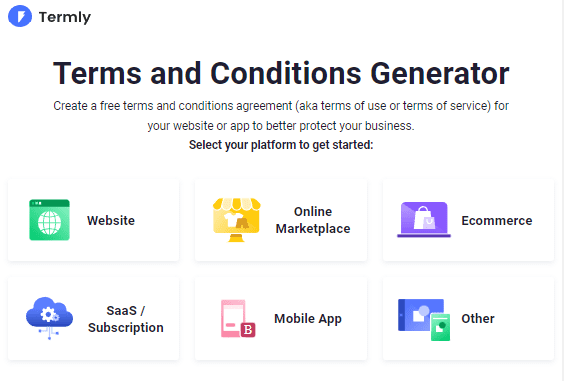
5. Write & Publish Blog Posts
Now that you have your science blog set up, it’s time to write and publish your first post. To craft the perfect blog post, check out our in-depth guide on How to Write A Blog Post. Here we will go over specific tips for a science blog.
1. Brainstorm Topics
You should brainstorm 100 topic ideas for your science blog. This will ensure that you always have content to write about in your science blog.
The goal is to find topics for your science blog that your audience is searching for on Google. The type of content you write on your science blog will depend on your specific niche.
Here are a few science blog post ideas, you can potentially cover in your science blog:
- News
- List Posts
- How to Posts
There are a few ways to brainstorm specific content:
Look at Competitors
If you want to be a successful science writer, you need to be constantly writing new content. But coming up with new topics to write about can be tough.
One way to come up with new topic ideas is to look at the articles your competitors are writing about. This will give you an idea of what topics are popular in your niche and how you can uniquely write about them.
To find your competitors, you can just google your keyword and look at the top search results. Once you find a few competitors, you can start looking at their blog posts and brainstorming how you can write about similar topics in a unique way.
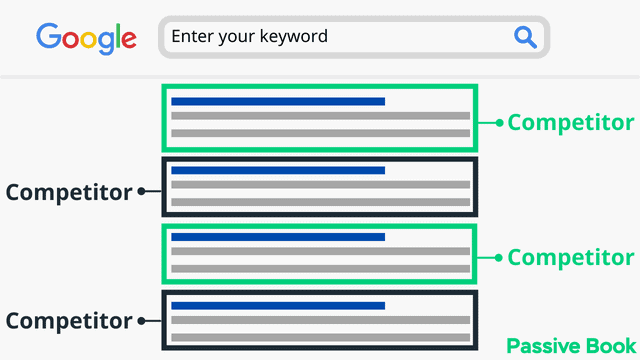
Do Keyword Research
Another way to come up with new topic ideas for your science blog is to do keyword research. This will help you find keywords that your audience is searching for in Google.
You can use a tool like KeywordTool.io to help you find these keywords. Just type in a keyword related to your niche and it will give you a list of related keywords.

Then, you can take these keywords and use them to brainstorm new blog post ideas.
Community & Forums
Another great way to come up with content ideas for your science blog is to look at online communities and forums. This is a great way to get feedback and ideas from people who are interested in your niche.
You can also get topic ideas from Facebook Groups, Reddit, and Quora.
2. Create an Editorial Calendar
Once you have a list of content ideas, it’s time to start creating an editorial calendar. This will help you organize your content and make sure you are constantly publishing new content.
Your editorial calendar should include:
- The title of your blog post
- A brief description of your blog post
- The target keyword for your blog post
- The date you plan to publish your blog post
Download Content Calendar Template

Steal our exclusive content calendar template. Have it delivered directly to your inbox:
You can use Google Sheets or Trello to create your editorial calendar.
3. Write a Blog Post
Now it’s time to start writing your blog post.
Write 5x Faster with AI
You can write your new blog post at 5x speed using the AI writing software Jasper. I was able to write over a hundred blog articles in 3 months using Jasper. This blog article you are reading right now was written with the help of Jasper. AI will not only help you write blog posts fast but also with higher quality.
Jasper can write plagiarism-free blog content, articles, social media content, emails, and ad copy. All you have to do is provide a few inputs on what you want and Jasper will do all the hard work of creating the blog content for you. No more writer’s block.
Check out the video below to see Jasper in action:
Try Jasper for free using the links on this page and get 10,000 bonus credits you can use to start writing your first articles.
Once you sign up for Jasper I recommend you spend some time going through the tutorial videos in the Jasper Bootcamp to truly unlock the power of this amazing software.
Check out our guide on How to Write a Blog Post Fast in 15 mins Without Losing Quality for more tips to write fast.
Research summaries
Research summaries are blog posts that summarize and explain recent scientific studies and research findings. You can read scientific papers and simplify them to make them more accessible to the masses. These types of posts are a great way to keep your readers informed about the latest developments in science and research.
Some examples of research summary blog post titles could be:
- “The Latest Findings on Climate Change”
- “A Breakthrough in Cancer Research”
- “New Study Reveals Surprising Results on Mental Health”

When writing a research summary, it’s important to make sure that you are accurately summarizing the study and providing context for the findings. Be objective in your presentation of the information and provide a balanced view of any potential limitations of the study. Cite your sources properly and include a link to the original study.
Explainer articles
Explainer articles are blog posts that explain complex scientific concepts in simple terms for a general audience. These types of posts are a great way to make science accessible to a wider audience and to help educate people about the world around them.
Some examples of explainer article blog post titles could be:
- “What is Quantum Mechanics and How Does it Work?”
- “The Science of Sleep: Understanding the Stages of Sleep”
- “How Do Vaccines Work to Protect Against Disease?”

When writing an explainer article, it’s important to break down complex concepts into manageable pieces and to use clear, easy-to-understand language. Provide examples and analogies to help illustrate the concepts. Include images, videos, or infographics to make the post more engaging and to help explain the concepts.
Opinion pieces
Opinion pieces are blog posts that share the writer’s thoughts and opinions on current science-related topics and issues. These types of posts allow writers to express their personal perspectives and stimulate discussion among readers.
Some examples of opinion piece blog post titles could be:
- “Why We Should Invest More in Space Exploration”
- “The Pros and Cons of Genetic Engineering”
- “Why Climate Change Denial is Dangerous”

Be clear about your stance on the issue and provide evidence to support your position. Also, be respectful of opposing views and consider alternative perspectives. Include counterarguments and provide a balanced view of the issue.
Interviews
Interviews are blog posts that feature scientists, researchers, or experts in a particular field and share their insights with your readers. These types of posts can provide valuable information and perspectives, and can also help to humanize the scientists and researchers in the field.
Some examples of interview blog post titles could be:
- “An Interview with a Leading Climate Change Researcher”
- “Q&A with a Nobel Prize-winning Physicist”
- “A Conversation with a Leading Biotech Entrepreneur”

Research the person you are interviewing and prepare a list of thoughtful and relevant questions. Be respectful of the person’s time and be mindful of their privacy. Get their permission to publish the interview and include a brief bio of the interviewee.
Science News
One of the most popular types of content in science blogs is news posts. These are articles that talk about the latest science news.
Some examples of new posts include :
- Clues to Extra Terrestrial Life on Europa
- Promising treatment for Dementia
- Tech Improvement for making semiconductors.

To write a news post, you need to find a study or article that is relevant to your niche. You can cover old studies and articles as long as it is interesting to your audience. Once you find an article, you can start writing your own take on it.
Make sure to include a link to the original article or study in your blog post.
List Posts
Another popular type of content in science blogs are list posts. These are articles that list out a bunch of information on a specific topic.
Some examples of list posts include:
- 15 Best Science Projects for Students
- 17 Scary Universe Facts
- 10 Major Current Environmental Problems

To write a list post, you need to come up with a list of items that are relevant to your niche. Once you have your list, you can start writing about each item in detail.
Make sure to include images and videos in your list post to make it more engaging.
Have the most interesting or less known item in your list as the first item. Have the most obvious item as the last one. This will draw your readers in.
How To Posts
Another popular type of content in science blogs are how-to posts. These are articles that teach your audience how to do something.
Some examples of how to posts include:
- How To Grow Your Own Food
- How To Make Your Own Solar Panel
- How To Build A Wind Turbine

To write a how-to post, you need to find a topic that is relevant to your niche. Once you find a topic, you can start writing about how to do it step by step.
Make sure to include images and videos in your how-to post to make your how-to post more engaging and easier to follow.
Outsource Writing
If you don’t have the time to write articles for your science blog, you can always outsource the writing. There are several sites where you can find writers, such as Fiverr and Upwork.

Just make sure that you take the time to interview potential writers and look at their samples before hiring anyone.
4. Add Images
Once you have written your blog post, it’s time to add images.
Images are a great way to make your blog post more engaging. People are more likely to read a blog post that has images.
When adding images to your blog post, make sure to add a caption and alt text. The caption is the text that appears below the image. The alt text is the text that appears when the image doesn’t load. The alt text helps optimize the images for search engines.
When adding images to your blog post, make sure to use the correct file format. The most common file formats are JPEG, PNG, and GIF.
JPEG is a good choice for photos and other images with a lot of colors. PNG is a good choice for images with text or logos. GIF is a good choice for animated images.
Ensure you compress your images and resize them to the correct dimensions so that you don’t end up slowing down your blog.
You can find images on stock photography sites:
Free Options: Pixabay, Pexels, Upsplash
Paid Options: Deposit Photos, Shutterstock, iStock, Getty Images, 123rf.
You can use Canva to edit your images for your blog post. Canva is a free online design platform that makes it easy to create beautiful visuals. You can add text, arrows, and other shapes to your images. You can also add filters and change the color of your text and shapes.
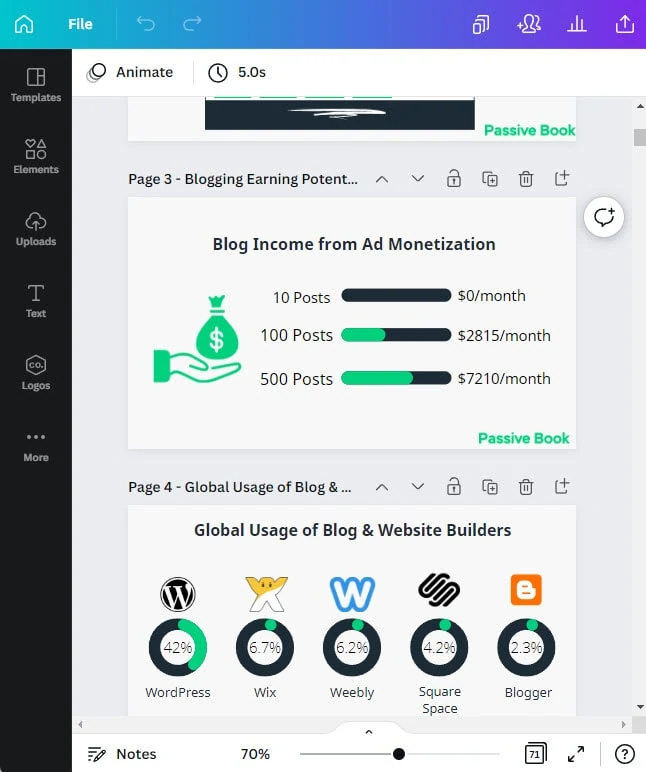
You can also access the library of stock images on Canva for free. However, the free library has a limited number of images. If you want access to all the images in the library, you’ll need to sign up for Canva Pro. The library has over 1 million images to choose from.
6. Promote Your Science Blog
Once you have written and published your blog post, it’s time to get people to read your blog. The readers of your blog are also known as blog traffic.
Search Engine Optimization (SEO)
SEO is the process of optimizing your blog posts so that they rank higher on the search engine results page (SERP).
When people are searching for information on the internet, they use search engines like Google, Yahoo, and Bing. If your blog post is ranking high in these search engine results pages, then you will get more traffic to your blog.
There are several ways to optimize your blog post for SEO.
- You can include keywords in your blog posts, title, introduction, and conclusion.
- You can include keywords in your alt tags.
- You can build backlinks.
Many factors go into SEO, and it can be a bit confusing to figure out where to start. You can master the more advanced SEO tactics by checking out our SEO Resources.

You can ensure you get the basics of SEO right, by completing the recommendations given by the RankMath plugin.
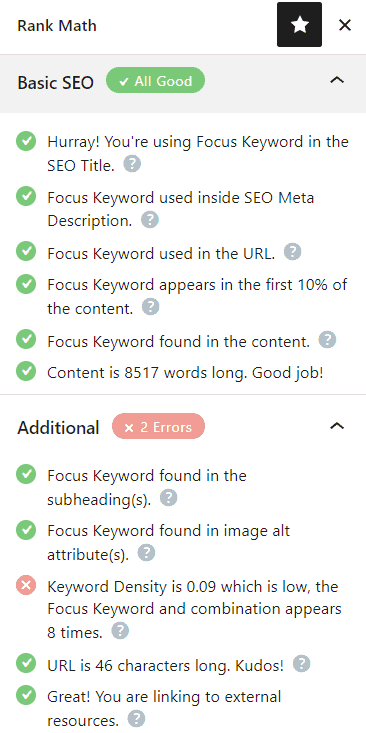
Email Marketing
Email marketing is a great way to promote your blog post. When you email your list, you are sending your blog post to people who have already shown an interest in your niche.
When emailing your list, make sure to include a link to your blog post. You should also include a brief summary of the blog post and why they should read it.
If you don’t have an email list, now is the time to start building one. You can start by creating a signup form and adding it to your blog. You can also offer a freebie, such as an ebook or mini-course, in exchange for people’s email addresses.
Once you have a list of email addresses, you’ll need to choose an email marketing service to manage your subscribers and send the emails.

You can use the Thrive Leads plugin to build opt-in forms to collect email addresses. You can then connect the opt-in form to an email marketing service like Active Campaign to send out the emails.
Check out our Email Marketing resources to learn more.
Social Media Marketing
Social media is a great way to promote your science blog. You can share your blog post on your social media accounts like Twitter, Facebook, and LinkedIn.
When sharing your blog post on social media sites, make sure to include a link to the post. You should also include a brief description of the blog post and why people should read it.
It’s also a good idea to use hashtags when sharing your blog post on social media. Hashtags are a way of categorizing your content and making it easier for people to find.
Guest blogging
Guest blogging is a great way to get exposure for your blog. When you guest blog, you write a blog post for another person’s blog. In exchange, they allow you to include a link back to your own blog. You can also promote your blog from the author’s bio.

When guest blogging, make sure to choose a blog that is relevant to your niche. You should also make sure that the blog has a good reputation and is popular in its own right.
When you write the guest blog post, make sure to include a link back to your own blog. You should also promote the guest blog post on your social media channels.
7. Monetize & Make Money
Once you have built up a loyal following, you can start to monetize your blog. There are several ways to make money from your blog.
Advertising
One way to monetize your blog is through advertising. You can sign up for an advertising network to get started. They will give an ad code to insert into your blog. When people view or click on your ad, you will earn money. So the earning potential is dependent on how much traffic you get.
To start advertising on your blog, you can sign up for an ad network like Ezoic (they pay more than Google Adsense). When your blog starts getting more than 100,000 page views a month you can monetize with Adthrive.
| Ad Network | Earnings Per 1K Impressions (EPM) | Monthly Traffic Requirement |
|---|---|---|
| Ad Thrive | $13 | 100,000 |
| Ezoic | $3 | 10,000 |
| Media.net | $1 | – |
| Google Adsense | $1 | – |
Affiliate Marketing
Another way to monetize your blog is through affiliate marketing. This is where you promote other people’s products on your blog and earn a commission when someone buys the product.
To get started with affiliate marketing, you need to sign up for an affiliate program. Once you have signed up, you will be given an affiliate link to promote the product.
When someone clicks on your affiliate link and buys the product, you will earn a commission.
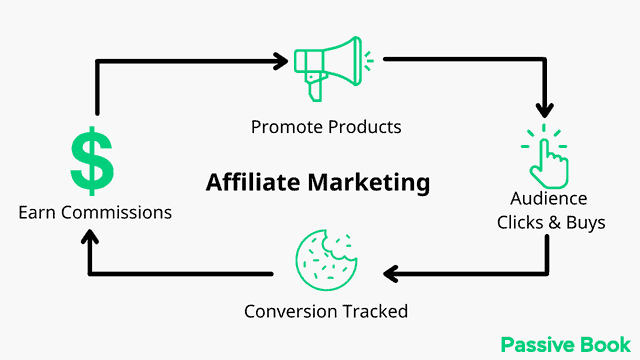
One of the most popular affiliate programs for science bloggers is the Amazon Associates program. You can find other affiliate programs by searching for “affiliate program” + your niche or by looking at what your competitors are promoting.
Digital Products
Another way to make money from your blog is by selling digital products. These are products that you create yourself and sell online.
Some examples of digital products include ebooks, video courses, and audio courses. The great thing about digital products is that they can be sold over and over again.
You can use Teachable if you want to sell video courses. Your students will have a dedicated course members area and a community system to ask questions and interact with each other. If you only want to sell eBooks, you can use SendOwl which lets you sell your digital products and eBooks for free.
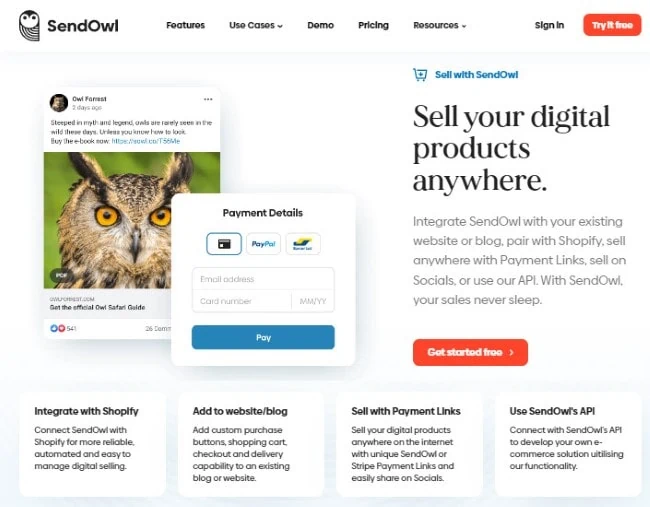
Sell Services
If you’re a science blogger with expertise in your field, you can also sell services. You can offer consulting, coaching, or writing services.
To sell services, you need to create a sales page on your blog. This is a page where you explain what services you offer and how much they cost.
You should also include testimonials from previous clients to show that you are an expert in your field.
Physical Products
You can also use your science blog to promote and sell physical products. For example, you can sell merchandise like t-shirts and mugs with catchy slogans or your blog’s branding.
You can sell these products with Print on Demand, which means that you don’t have to hold any inventory.
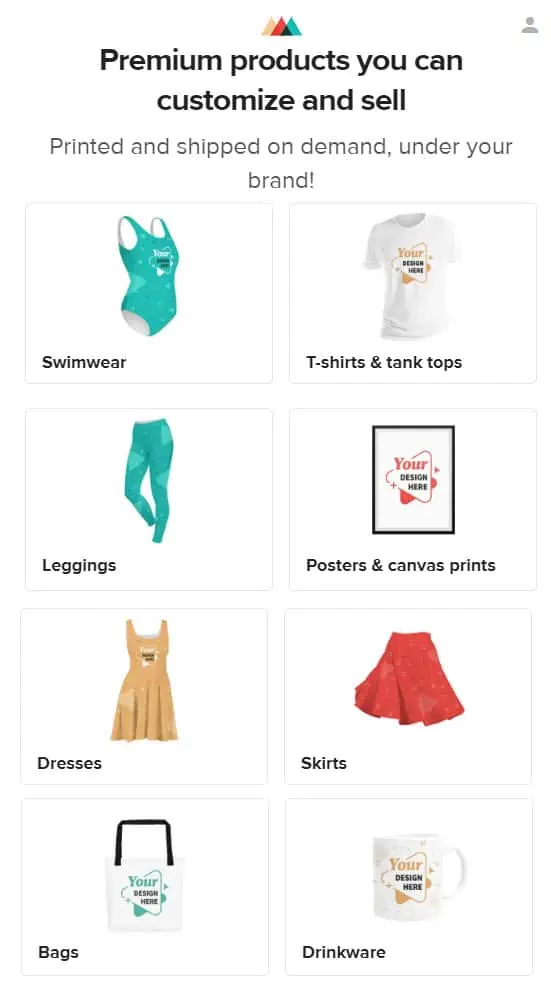
To get started, you need to create designs for your products and then upload them to a platform like Printful. The platform will then take care of printing and shipping the products to your customers when a customer places an order.
You can then promote these products in your science blog.
Sponsored Posts
Another way to monetize your blog is through sponsored posts. This is where you write a post that promotes a company or product in exchange for money.

To get started with sponsored posts, you need to reach out to companies and pitch them your idea. If they are interested, they will then give you money to write the post.
It’s important to make sure that the sponsored post is clearly marked as an advertisement. You should also disclose any relationship you have with the company.
FAQ
How long should a science blog post be?
A science blog post can be as long or as short as you want it to be. However, it’s generally recommended that a blog post be at least 1000 words.
How often should I post on my science blog?
This is up to you. You can post as often or as little as you want. However, it’s generally recommended that you post at least once a week to keep your audience engaged.
How do I choose a good science blog name?
Your science blog name should be reflective of the content you’ll be writing about. We recommend you combine two words to create your blog name. One of the two words should be a word from your niche. For example, Psych Central is a blog about psychology. Try to keep the blog name short, and easy to remember, and spell.
What Next?
If you’re interested in learning more about science, or if you want to share what you learn with others, starting a science blog might be the perfect way to do it.
We hope this guide showed you how to start a science blog.
If you have any questions as you set up your new blog, leave a comment below so we can help you out.
Have you started your science blog yet? What type of science blog are you going to start? Let us know in the comments below.
Share this post with your friends & followers:
